Physical Address
304 North Cardinal St.
Dorchester Center, MA 02124
A detailed classification of myeloproliferative disorders is complex and constantly in flux, with continued advances in immunophenotyping, gene rearrangement studies, fluorescence in situ hybridization, microarrays, comparative genomic hybridization, and laser-based microdissection. Indeed, this chapter was without a doubt the worst chapter in the first edition of this book, so a complete overhaul was needed. Many classification schemes have come and gone over the years. The most recent one in common use is that of the World Health Organization (WHO). In this book, some of the original headings have been preserved, even though they do not correspond exactly to the WHO schema. It has been joked that a more simplified classification of lymphomas should consist of good ones, bad ones, in-between ones, and the ones that are not what they seem. This chapter will focus mainly on lymphomas that are primary in the skin. Systemic lymphomas (often called nodal lymphomas) may secondarily involve the skin, often with a worse prognosis. Although selected features of skin biopsies can help to distinguish primary from systemic lymphoma, typically a more detailed workup, including imaging, flow cytometry, bone marrow assessment, and other ancillary studies, are needed. The services of a hematopathologist or a dermatopathologist with a special interest in these disorders may be needed for an exact classification of a case.
Lymphomas are difficult to distinguish from benign reactive lymphoid proliferations (24.14). One problem is that reactive lymphoid cells may interact with or obscure the malignant clone, causing difficulty in its identification. For example, reactive CD20 + B cells can be found in some cases of T-cell lymphoma. Another problem is that monoclonality does not always indicate malignancy. For example, abnormal gene rearrangement results have been reported in apparently benign conditions, such as lichen planus (2.11), pityriasis lichenoides (2.14), purpura pigmentosa chronica (4.8), lichen sclerosus (9.5), and pseudolymphoma (24.14). It is important to realize that most benign “rashes” involve mostly T lymphocytes, so that looking for T-cell lymphoma is much more complicated than just looking for T cells! Immunomarkers have become more important, as oncologists develop more targeted therapies directed against specific antigens, such as zanolimumab (anti-CD4), rituximab (anti-CD20, expressed in most B-cell lymphomas), alemtuzumab (anti-CD52), and denileukin diftitox (anti-CD25). Refer to Chapter 30 for summaries of many of the immunostains used heavily for these disorders. A key point is to remember that you cannot just memorize which lymphoma is positive for which immunostains, because the architecture is important too, especially within nodes. In other words, you have to know where the cells are located, and also which antigens they co-express. Although bcl-2 is positive in certain B-cell lymphomas, it is positive in normal T-cells in normal nodes, and in normal B cells in the mantle zone of nodes, so you have to make sure those cells in a purported B-cell lymphoma are actually B cells, and not T cells expressing this marker! Furthermore, bcl-6 is positive within normal germinal centers, but is positive outside those germinal centers in cutaneous follicular center lymphoma. Normal germinal centers in lymph nodes and reactive lymphoid hyperplasia (pseudolymphoma) in the skin are bcl-6 +, bcl-2-neg, and CD10 +, with CD21 and CD23 staining a dendritic cell network. Normal germinal centers have a high proliferative index with Ki-67.
(see Fig. 24.1A–G )
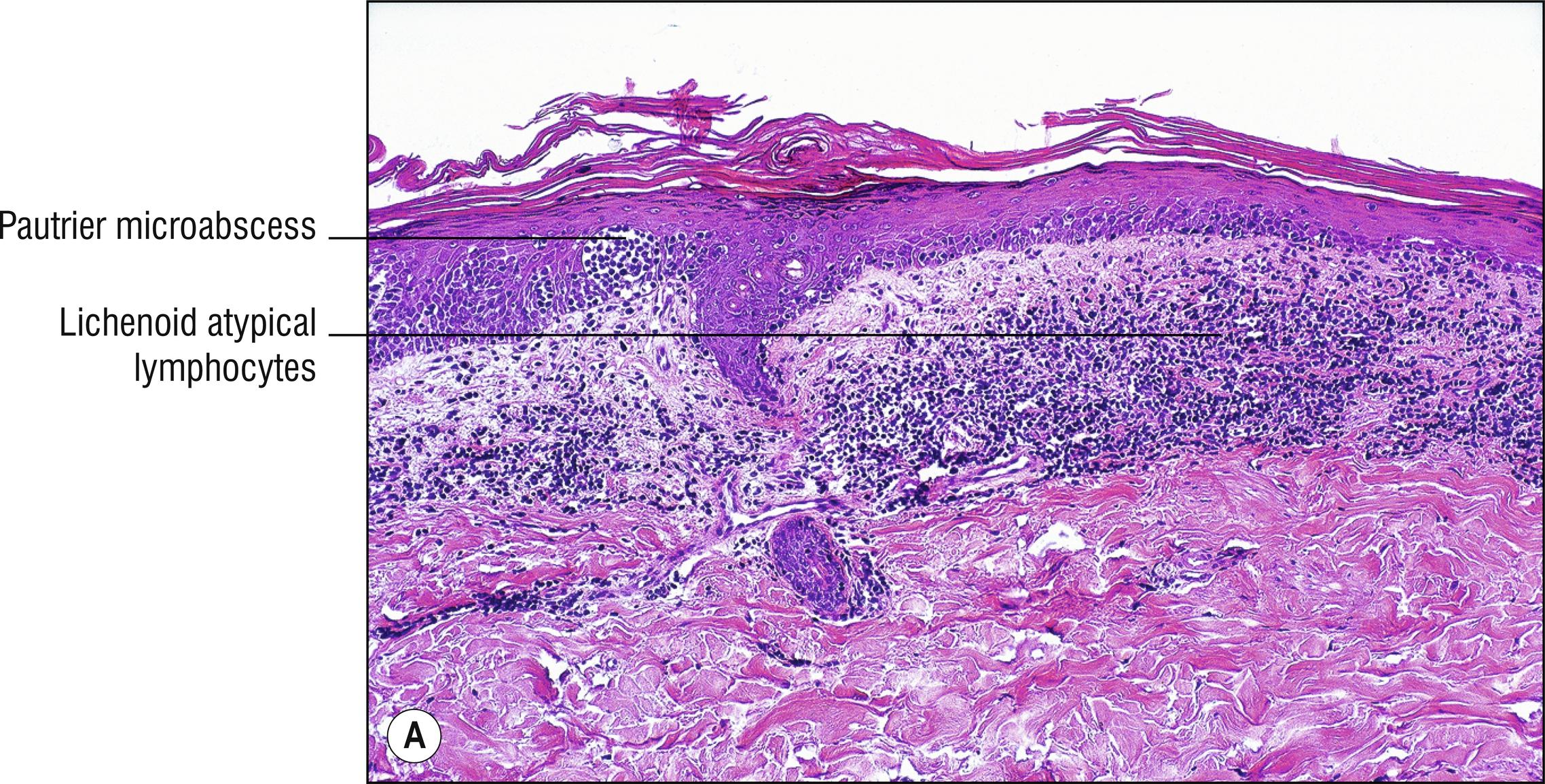
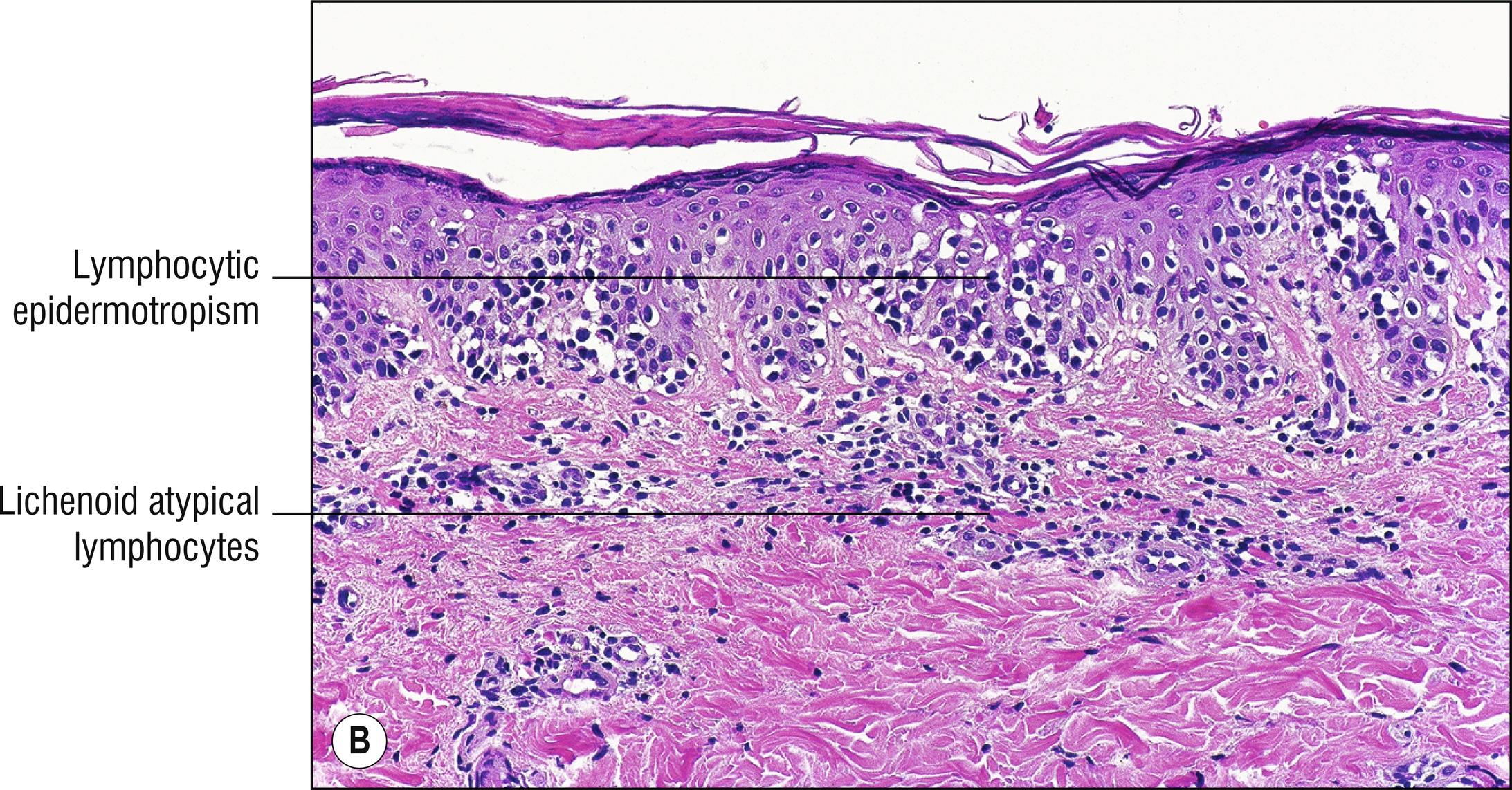
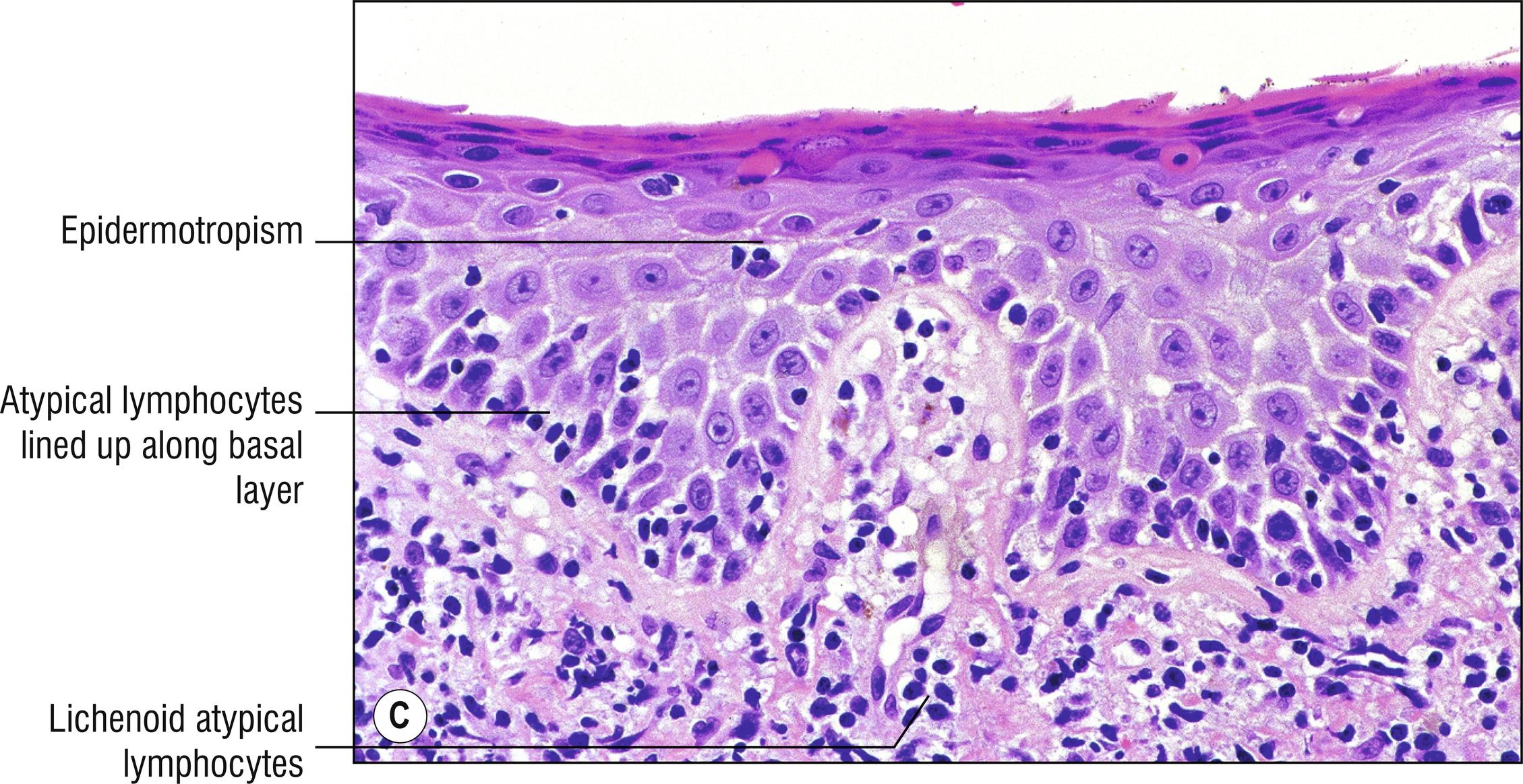
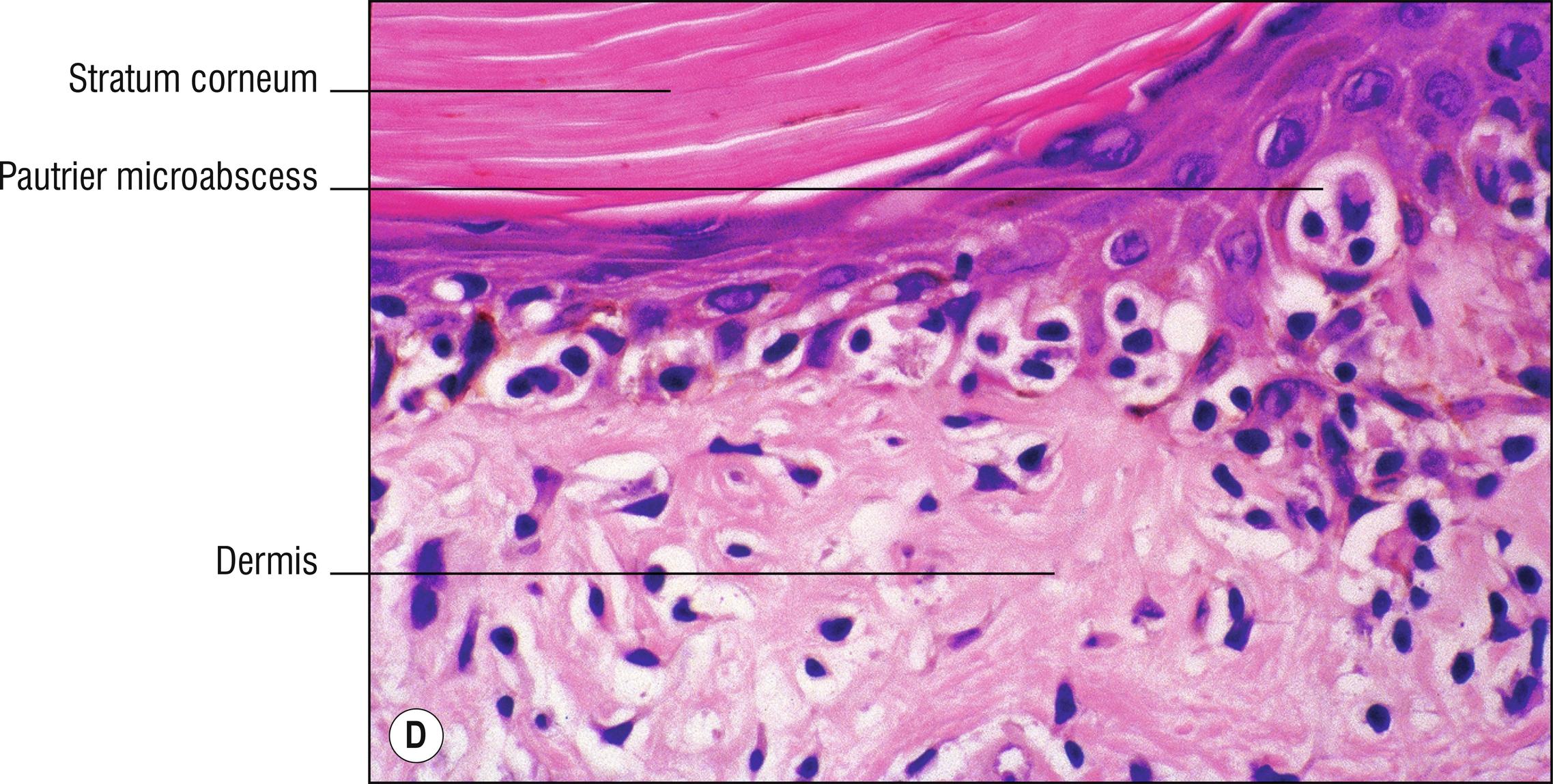
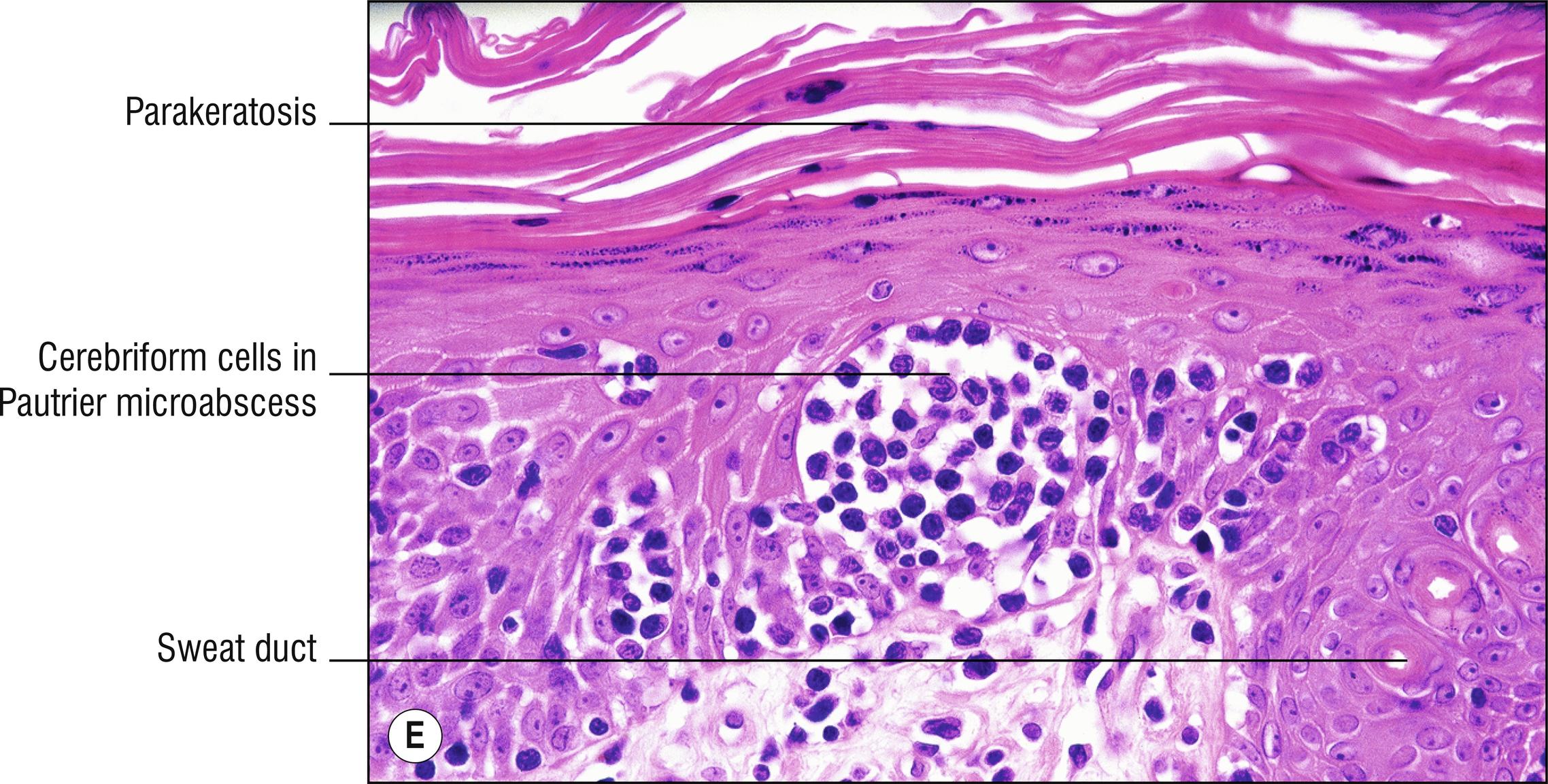
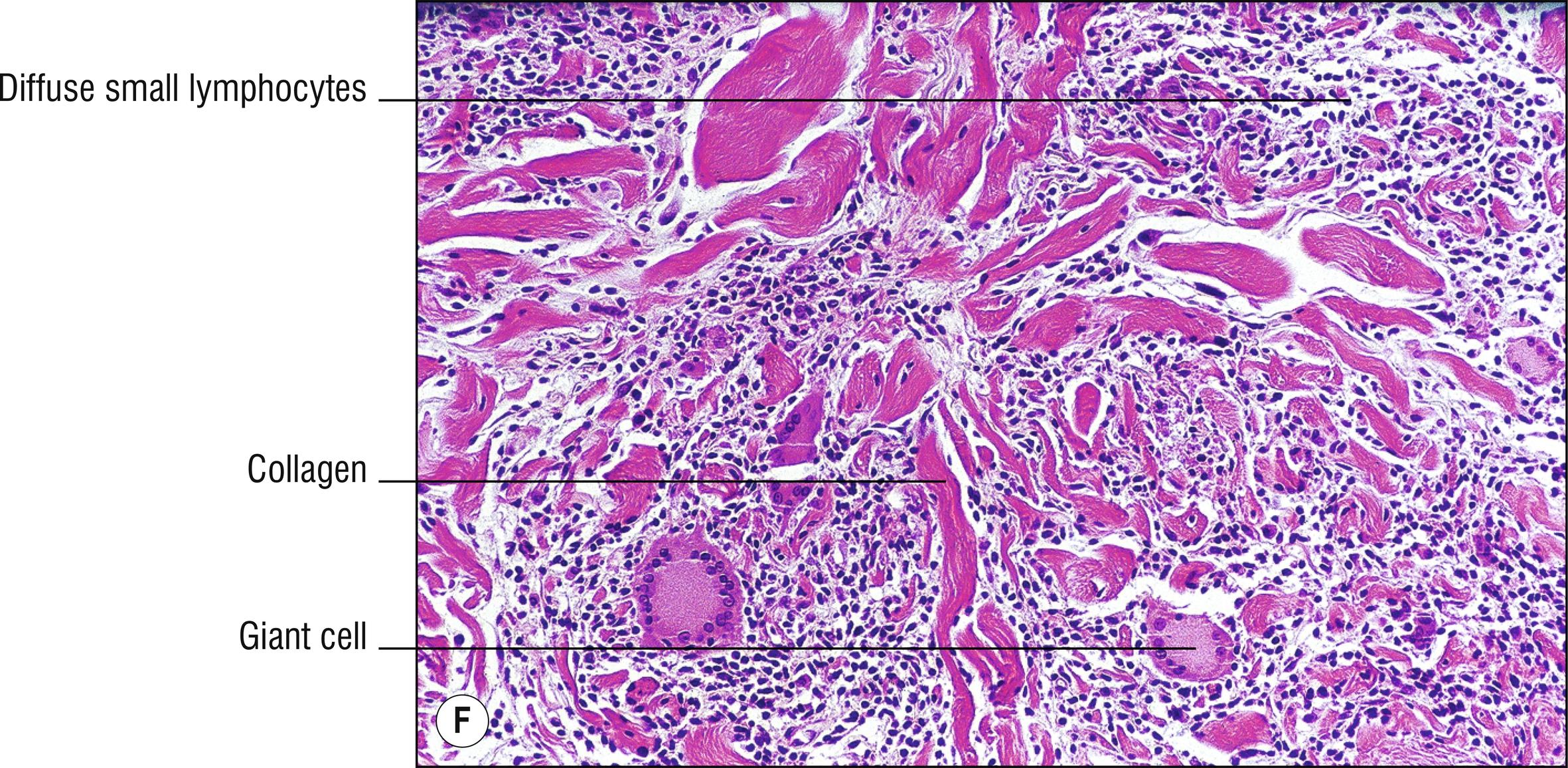
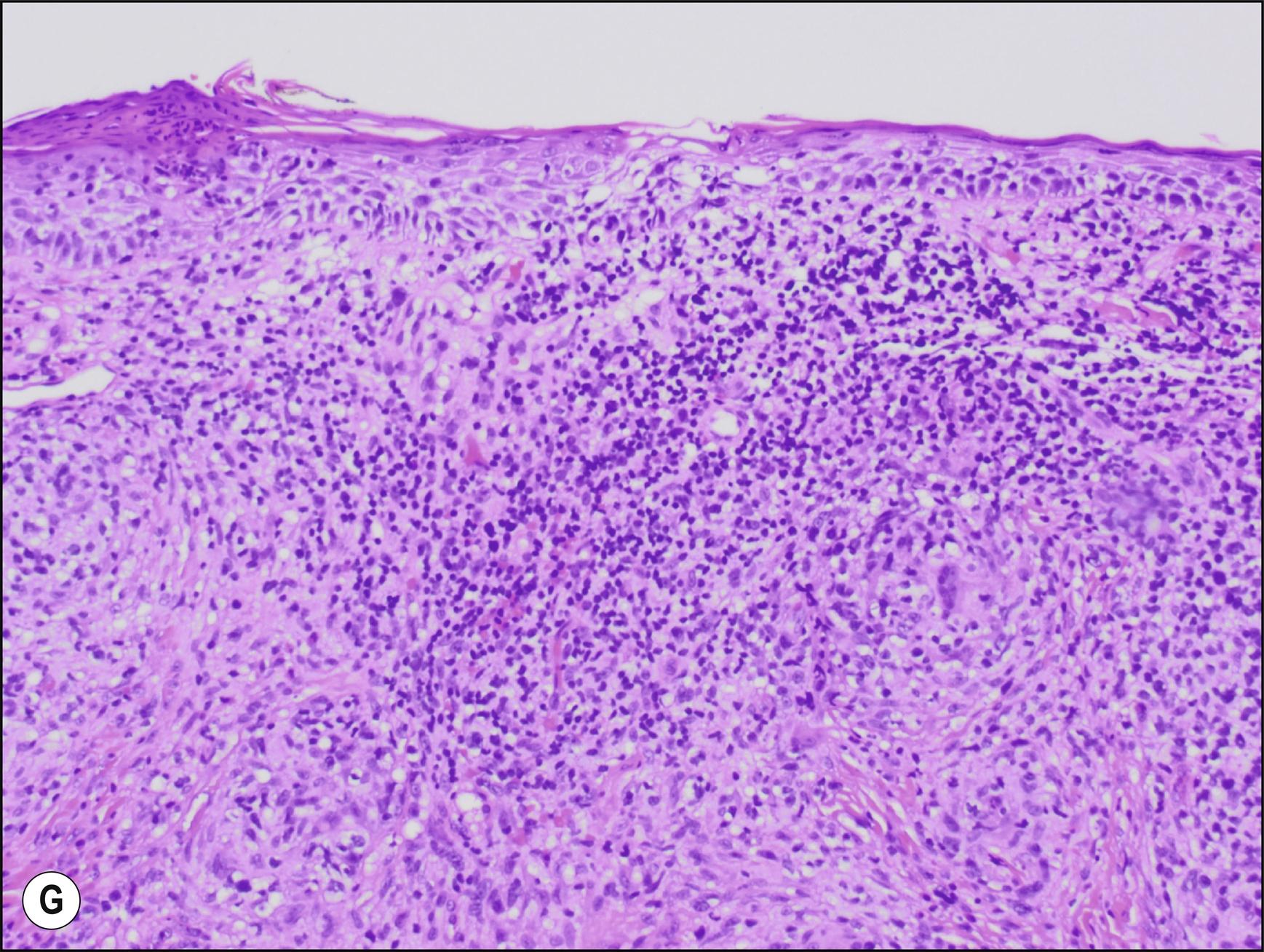
MF has nothing to do with fungus, despite the unfortunate name. It is the most common prototypic form of cutaneous T-cell lymphoma (CTCL), hence it has its own section in this book. Most CTCL is MF, but MF is just one type of CTCL. The other T-cell lymphomas have been moved to Sections 24.2 through 24.7. The classical Alibert–Bazin type of MF has three stages. Initially, eczematous patches (1.29), especially of the hip and buttock , often persist for years and are difficult to distinguish from eczema. Second, papulosquamous plaques develop (1.103). Third, tumor nodules (1.92) appear. About 90% of patients never progress to tumor stage and do not develop systemic disease. Therefore routine staging investigations (imaging scans, bone marrow biopsies, etc.) are not recommended in patch stage patients. Lymph node, liver, spleen, lung, and bone marrow involvement are usually late findings. Dermatopathic lymphadenopathy (benign nodes reacting to the skin) is difficult to distinguish from lymph node involvement by malignant cells.
Epidermis may be atrophic (1.9), hyperplastic (1.61), or ulcerated (1.142)
Lichenoid or diffuse (1.91), less commonly just perivascular (1.109), atypical lymphocytes, sometimes with cerebriform nuclei, but sometimes just small banal-appearing lymphocytes, with eosinophils (1.36), and plasma cells (1.111)
Epidermotropism of the atypical lymphocytes often, sometimes producing single cell “punched-out” holes (“haloed nuclei”) in the epidermis, or larger spaces filled with these lymphocytes ( Pautrier microabscesses , also known as Darier’s nests since he described it first), or prominently lining up at the dermal–epidermal junction. Epidermal lymphocytes tend to be larger and more atypical than those in the dermis. Epidermotropism often less prominent in older nodules. The dermal lymphocytes sometimes appear on the epidermal side of the superficial vascular plexus, on their way to the epidermis, leaving an absence of lymphocytes below the vessels, producing the overrated “bare underbelly sign.”
Spongiosis usually not seen in most cases, unlike eczema. MF has too much epidermotropism for too little spongiosis (“too much for too little”)
Follicular mucinosis sometimes present (10.8)
Most lymphocytes exhibit positive staining with T-cell markers (CD2, CD3 , CD5), most often with increased T-helper cells (CD4) and fewer suppressor-cytotoxic T cells (CD8), the normal 2:1 ratio of CD4:CD8 is usually more than 3 : 1. Loss of pan-T-cell markers such as CD7 , and less commonly CD43 or CD5, has been stressed as helpful, but this may not be as specific as advertised
Identification of CD25 (IL-2 receptor) positive cells is useful prior to therapy with denileukin diftitox (Ontak). Positive staining for CD52 is useful for possible alemtuzumab (anti-CD52, Campath) treatment. Positive staining for cytotoxic proteins (granzyme, perforin, TIA-1) indicates more aggressive subtype (some would not classify this as true mycosis fungoides)
Clonal T-cell receptor (TCR) gene rearrangements may be present in 60% of patients with patch stage MF, 65% of more advanced MF, and 20% of benign inflammatory conditions. The gene rearrangement is usually alpha–beta, but sometimes gamma–delta
Papillary dermal collagen often said to be wiry, resembling fettuccine, but this is overrated as a diagnostic help
Woringer–Kolopp disease (pagetoid reticulosis): solitary patch or plaque of MF with prominent epidermotropism , most common on the distal limbs. The atypical cells are characteristically CD3 +, CD4neg, CD8 +, CD45RO +, CD20neg, CD30neg, CD79a neg. Sometimes CD4 + more than CD8 +. Good prognosis.
Poikiloderma atrophicans vasculare (PAV): poikilodermatous changes are dominant (1.112), more common on trunk, more epidermal atrophy (1.9), interface (1.64), or lichenoid lymphocytes (1.72), telangiectasia (1.136), melanin incontinence (1.79), and extravasated erythrocytes (1.40).
Granulomatous T-cell lymphoma: very rare form of MF in which granulomatous infiltrates in the dermis may cause confusion with benign granulomas (1.51). Epidermotropism may be helpful when present.
Granulomatous slack skin: very rare, patches or plaque eventually result in hanging folds of skin , especially in the axilla (1.10) and groin (1.55), due to fragmented elastic fibers (1.31) like in cutis laxa (9.10). Sometimes associated with Hodgkin lymphoma (24.15). Pathology similar to granulomatous T-cell lymphoma: diffuse small lymphocytes , immunostaining as in MF, epidermotropism sometimes slight, multinucleated giant cells (1.84) that contain lymphocytes or elastic fibers stain with macrophage stains such as lysozyme and CD68.
Hypopigmented MF: hypopigmented (1.150) macules, often in young patients with black skin , more likely to express CD8 more than CD4, yet it is usually not aggressive, unlike primary cutaneous aggressive epidermotropic CD8 + cytotoxic T-cell lymphoma (24.6). It may be difficult to distinguish from atopic dermatitis (2.1) and the inflammatory stage of vitiligo (17.2). The term white spot parapsoriasis has been used when there is insufficient evidence to confirm the diagnosis as MF or eczema.
MF in young patients: MF is rarely found in children, more likely to be hypopigmented or resemble pityriasis lichenoides (2.14). In most cases, there are patches with an indolent and non-aggressive course.
MF palmaris et plantaris (dyshidrosiform MF): scaly plaques or vesicles of the palms or soles (1.100), which may resemble eczema (2.1) and may be an example of overdiagnosis based upon excessive reliance on lymphocyte marker studies.
MF d’emblee: aggressive subtype wherein tumor nodules develop without the usual previous patch or plaque stages . Most of these patients actually have CD30-positive anaplastic large cell lymphoma (24.5) or natural killer (NK)/T-cell cytotoxic lymphoma (24.6), and generally no longer considered to have a type of MF.
Follicular MF (folliculotropic, pilotropic MF): prominent clinical and pathological follicular involvement (1.47), often sparing epidermis, sometimes with infundibular cyst formation, not necessarily with follicular mucinosis (10.8), often head and neck.
Syringotropic MF: prominent involvement around the sweat glands.
MF with gamma-delta (γ–δ) gene rearrangement and MF with CD8 + predominance has the normal progression of chronic patches and plaques of ordinary MF, unlike the more aggressive primary cutaneous γ–δ T-cell lymphoma and the aggressive primary cutaneous epidermotropic CD8 + T-cell lymphoma (both 24.6).
Interstitial MF: resembles interstitial granuloma annulare (7.1). Epidermotropism may be a clue toward the diagnosis.
Papular MF: small papules are present instead of patches or plaques, does not have spontaneous regression as found in lymphomatoid papulosis type B (24.5).
Invisible MF: patients have no visible patches or other skin lesions, but biopsy shows MF.
Erythrodermic MF: generalized exfoliative erythroderma (1.39), but lacks the leukemic phase of Sezary syndrome (24.1).
MF with large cell transformation: large cells are usually but not always CD30 +, usually appears with later stage of MF with worse prognosis, may overlap with other CD30 + lymphoproliferative diseases (24.5).
Other lymphomas and leukemias in this chapter.
Eczema (2.1) and contact dermatitis (2.2): clinically more responsive to corticosteroids, more spongiosis, less epidermotropism, less lichenoid and more perivascular lymphocytes, no atypical lymphocytes, no abnormal T-cell gene rearrangements, less likely to have CD7 depletion. In paraffin sections, epidermal lymphocytes of contact dermatitis are more commonly CD45RBneg, CD45RO +, whereas epidermotropic lymphocytes in MF are CD45RB +, CD45ROneg. In frozen sections and flow cytometry, MF lymphocytes are strangely typically CD45RO +.
Parapsoriasis (2.9): often used as a controversial term for persistent eczematous lesions for which it is uncertain as to whether they represent MF or not.
Actinic reticuloid (2.2): a chronic photodermatitis (like chronic actinic dermatitis or persistent light reactor) with atypical lymphocytes resembling MF, with CD4;CD8 ratio often less than 2, usually benign but persistent course.
Other diseases with epidermotropism (1.37), not to be confused with spongiosis (1.132). Langerhans microgranulomas (24.18) have been rarely reported in the epidermis of MF.
Lichenoid (1.72), interface (1.64), nodular and diffuse (1.91), and spongiotic (1.132) dermatitis. The following disorders are often mistaken for MF: lichenoid keratosis (18.8), lichen planus (2.11), pityriasis lichenoides (2.14), purpura pigmentosa chronica (4.8). T-cell receptor gene rearrangments have even been found in some of these disorders, compounding the problem.
(see Fig. 24.2 )
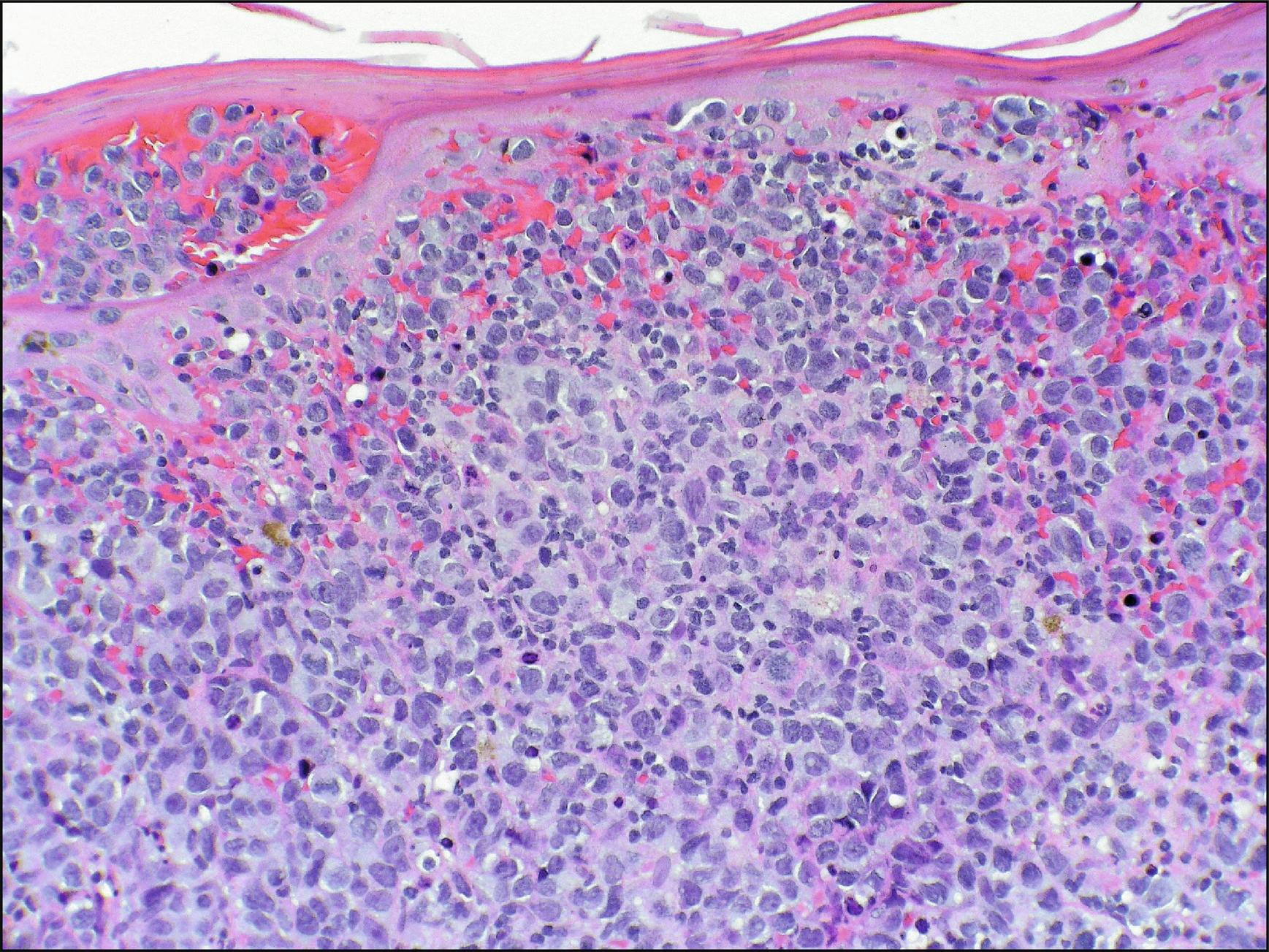
This can be considered to be the leukemic phase of MF , but now is considered a separate entity by WHO. Patients usually have exfoliative erythroderma (1.39), palmar–plantar involvement, and lymphadenopathy from the start, instead of progressing more slowly with patches or plaques as in MF. If a patient lacks sufficient Sezary cells in the blood, they are designated as having erythrodermic MF instead of Sezary syndrome.
By definition, more than 1000 Sezary cells per cubic millimeter in the peripheral blood (large cerebriform atypical CD4 + lymphocytes greater than 14 microns). The CD4 +:CD8 + ratio is often more than 10 : 1 with flow cytometry with most cells are CD7 −. The Sezary cells are negative for CD4. CD26 loss with flow cytometry has been found in 50% of cases, but this is less important than loss of T-cell markers CD2 and CD3, since loss of CD26 is found in 33% of cases of MF, and 15% of cases of benign dermatitis.
Otherwise routine histology and immunopathology similar to MF (24.1). In some cases the skin biopsy is non-specific and the diagnosis is made from the blood.
Clonal T-cell gene rearrangments in skin or blood as in MF.
This is associated with infection by the human T-cell lymphotropic virus type I (HTLV-1). Serology for this virus is available, and it can be detected within the atypical lymphocytes (transmitted sexually or by blood transfusion), not to be confused with HTLV-III (which is now called HIV-1, 14.12). Often called ATLL since it primarily affects adults, and latent infection with this virus prior to apparent disease is prolonged. Other patients have acute aggressive disease. More common in Japan, Africa, Caribbean, and south-eastern United States. Systemic involvement, lymphadenopathy , hypercalcemia , and osteolytic bone lesions (1.16) are common. Half of the patients have skin lesions: papules, nodules, or plaques.
Histology similar to MF in many cases (24.1), with or without epidermotropism, but lymphocytes in skin and blood sometimes multilobed (called “flower cells” in peripheral blood)
Usually CD3 +, CD4 +. CD25 routinely positive (unlike many cases of MF). CD30neg even though some patient have large atypical lymphocytes like CD30 + lymphoma (24.5). CD7 usually remains positive and does not become depleted
Gene rearrangements like MF often present
(see Fig 24.4 )
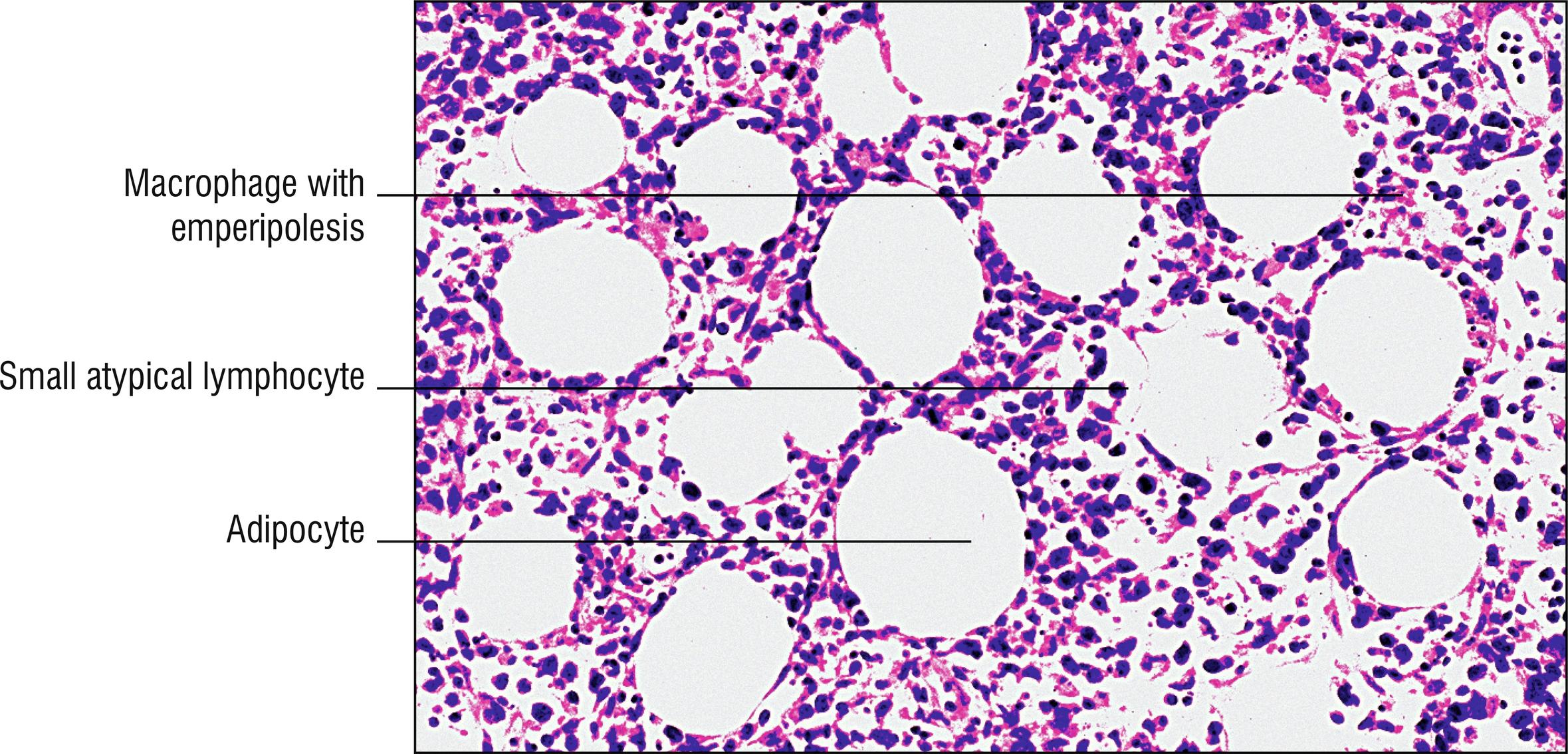
Subcutaneous “panniculitis-like” T-cell lymphoma (SPTCL) presents as nodules (1.92) or plaques, most common on the legs (1.67). Many cases are non-aggressive and indolent; other cases rapidly fatal. Hemophagocytic syndrome may occur, consisting of macrophages in bone marrow, liver, spleen or lymph nodes with cytophagocytosis, hepatosplenomegaly (1.75), fever (1.45), pancytopenia, and aggressive course.
Lobular panniculitis (often lace-like pattern of lymphocytes rimming adipocytes), without significant dermal or epidermal involvement
The malignant small lymphocytes are usually CD3 +, CD8 +, granzyme +, TIA-1 +, perforin + ( cytotoxic phenotype ). Sometimes the lymphocytes may be larger with more cytologic atypia
CD68 + macrophages often exhibit cytophagocytosis of erythrocytes or nuclear debris (“ bean bag cells ”)
Sometimes an alpha–beta (α–β) T-cell receptor gene rearrangement is present (BF-1 positive)
Other lymphomas can also appear in the fat, especially γ–δ T-cell lymphoma (24.6).
Panniculitis ( Chapter 16 ). C ytophagic histiocytic panniculitis is a term used for panniculitis with cytophagocytosis, some cases of which can be benign and reactive instead of lymphoma. May overlap with lupus panniculitis (17.6).
Similar emperipolesis can be seen also in Rosai–Dorfman disease (7.13). Phagocytosed erythrocytes and neutrophils are rarely seen in melanoma or squamous cell carcinoma.
(see Fig. 24.5A–G )
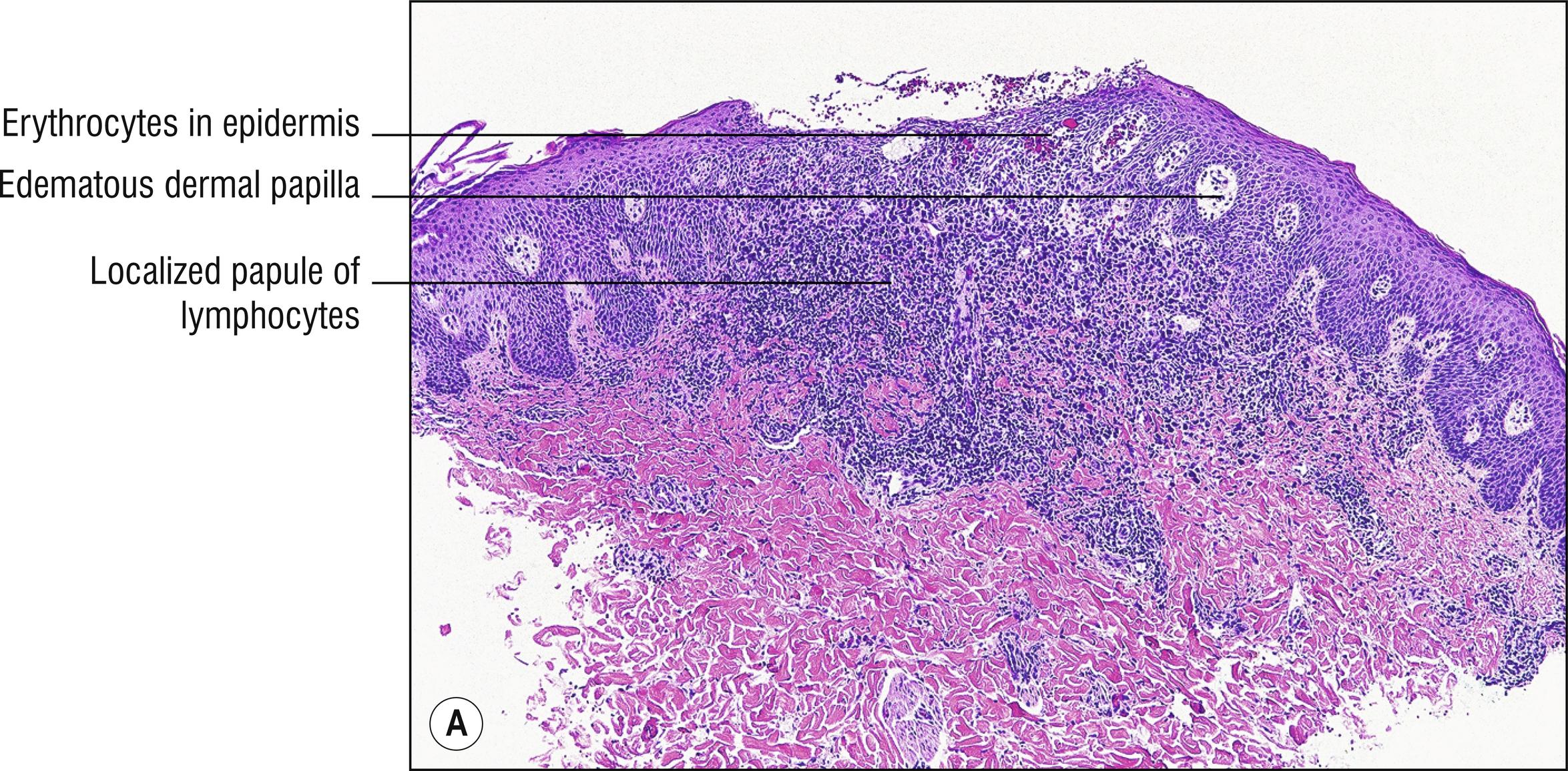
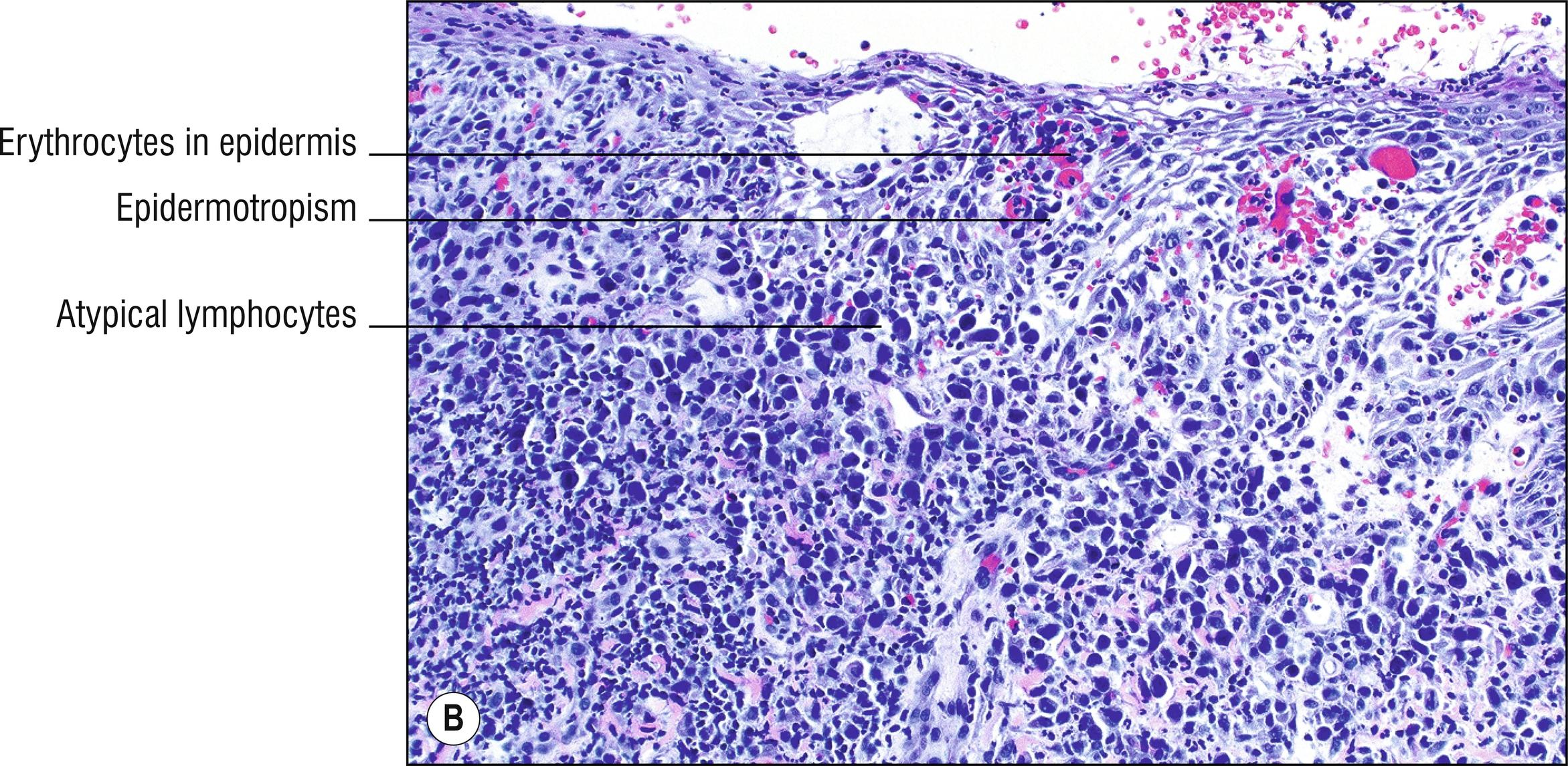
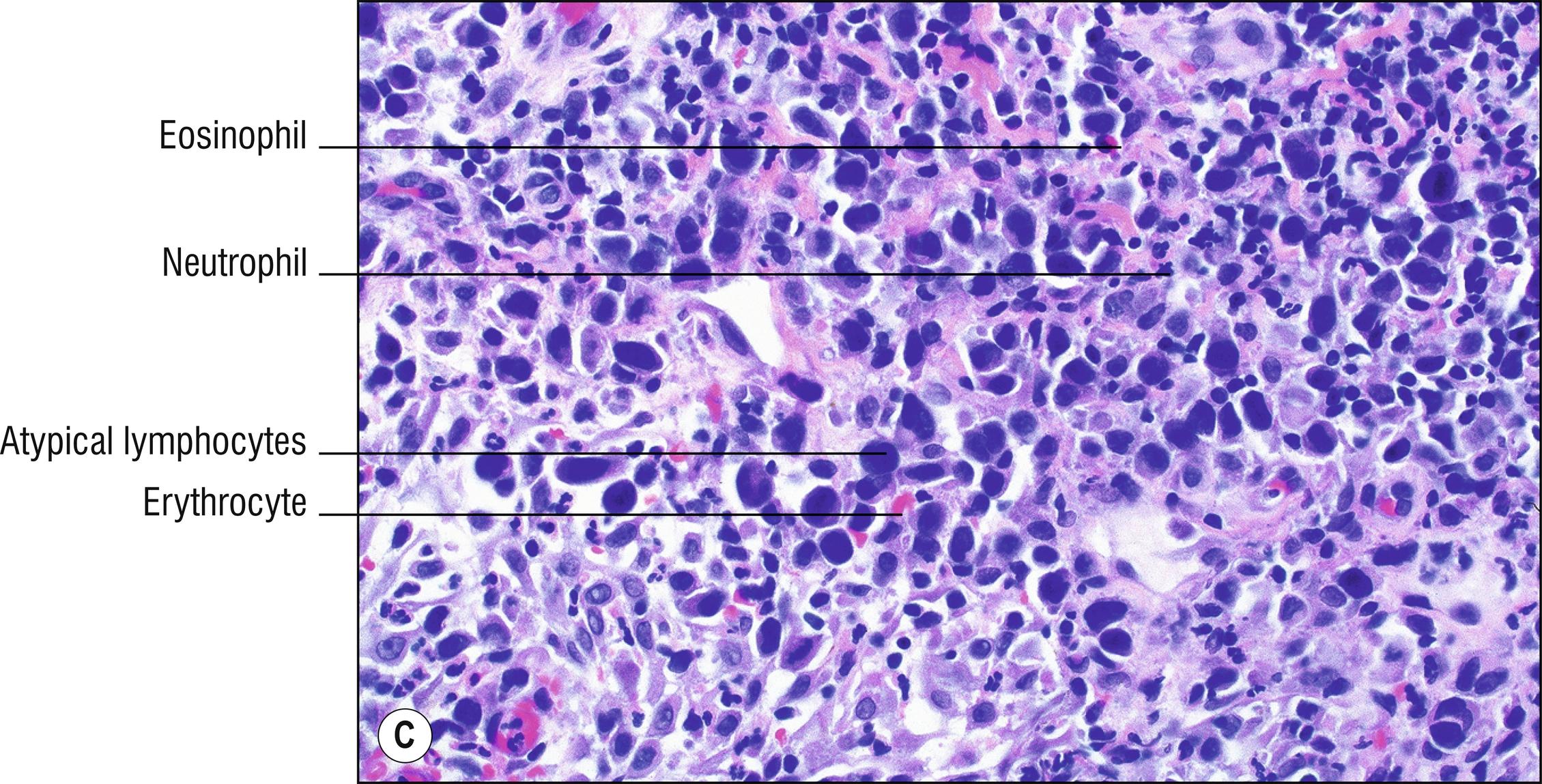
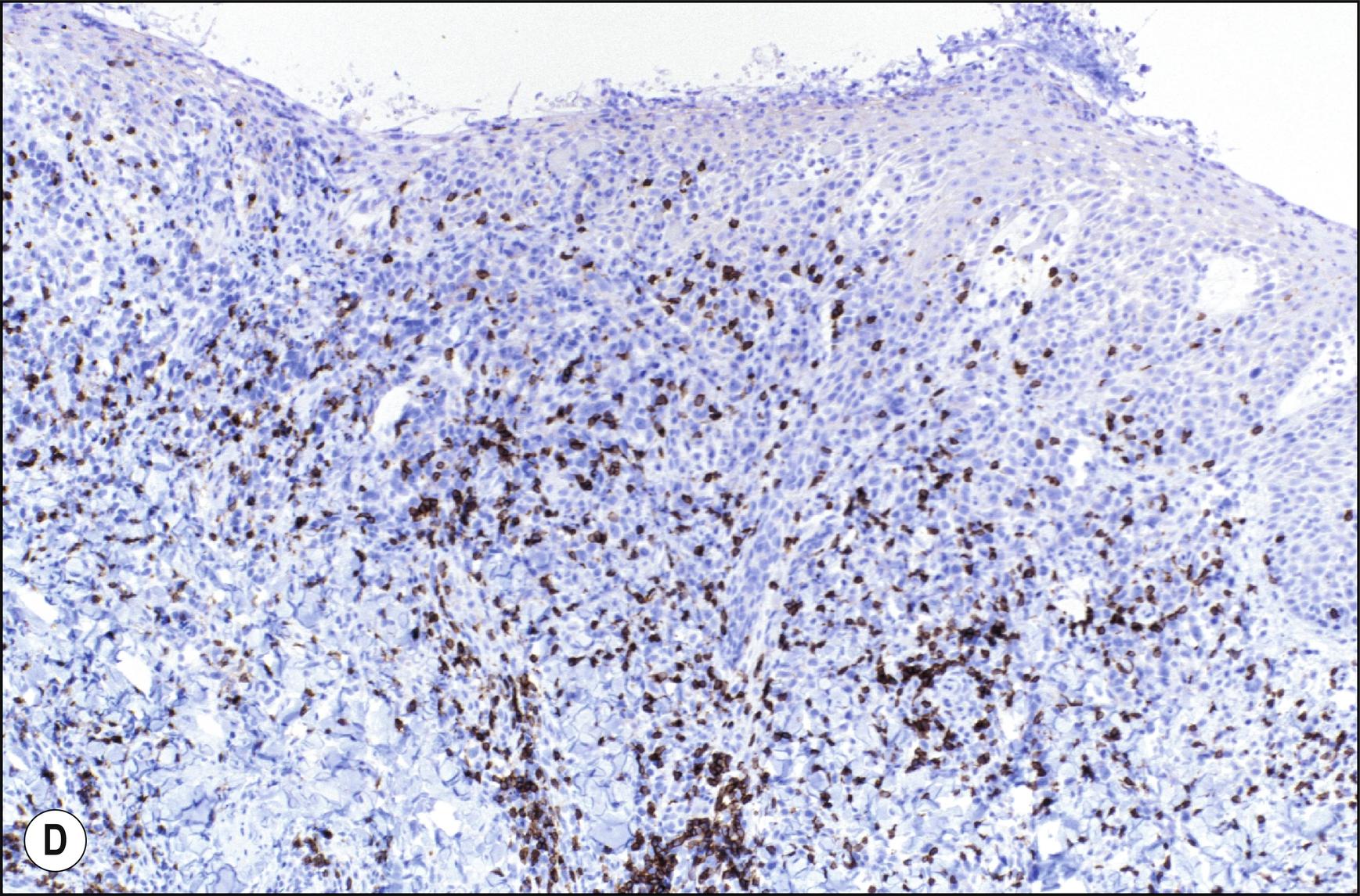
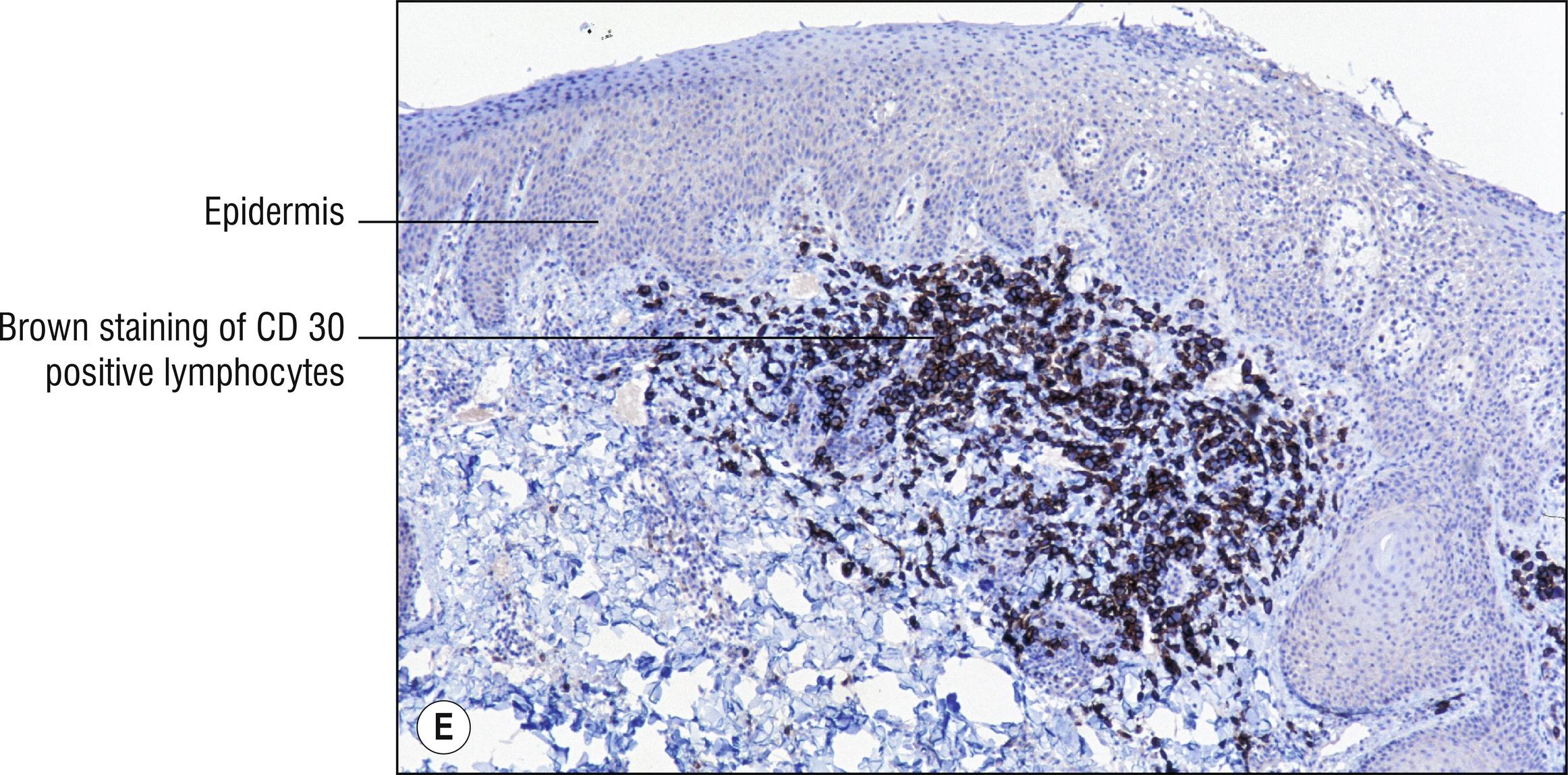


This is an uncommon group of lymphomas in which large atypical lymphocytes express CD30. Lymphomatoid papulosis (LyP) is a rare disorder, in which crops of papules or nodules , which sometimes ulcerate, appear and spontaneously regress . Lymphomatoid means resembling lymphoma, since the suffix -oid means resembling. The disease has a benign course in 90% of cases , but in 10% of cases, a bona fide lymphoma, usually Hodgkin’s disease or mycosis fungoides , develops. There is debate whether the patients all actually have lymphoma from the start, which is low grade and may regress, or whether benign disease (pseudomalignancy) actually transforms into lymphoma. DNA flow cytometry or T-cell receptor gene rearrangement tests do not predict which patients develop lymphoma.
Epidermal necrosis (1.87) often, or ulceration
Nodular infiltrate of ordinary lymphocytes, very atypical CD-30 positive activated T lymphocytes, with epidermotropism (1.37) into the epidermis
Neutrophils and eosinophils sometimes present
Extravasated erythrocytes (1.40), often with red blood cells in the epidermis
Depending upon the subtype below, CD8, CD56, TIA-1, or granzyme may be expressed. Molecular clonality is present in a majority of examples of LyP, but may also be found in reactive benign inflammatory conditions.
Type A LyP: Most common subtype, large (25–40 micron) CD30-positive atypical lymphocytes resemble histiocytes, found within localized wedge-shaped dermal infiltrate of lymphocytes, neutrophils and eosinophils as above, often with epidermotropism resembling MF.
Type B LyP: Mostly smaller (8–10 micron) cerebriform CD30neg lymphocytes with rare large CD30 + cells, with epidermotropism as in papular MF, but papules and nodules spontaneously remit.
Type C LyP: More impressive sheets of CD30 + large atypical lymphocytes, resembles ALCL below except lesions often come and go.
Types D LyP: epidermotropic CD8 + and CD30 + lymphocytes infiltrate the epidermis, mimics primary cutaneous aggressive epidermotropic CD8 + cytotoxic T-cell lymphoma (24.6).
Type E LyP: angiodestructive CD8 + small to medium lymphocytes.
Types F, G, H, and I LyP: have been described (when will it end?).
Primary cutaneous anaplastic large cell lymphoma (ALCL): If this is primary in the skin, it tends to regress, but if there is systemic (nodal) involvement, it can be rapidly progressive and fatal. Many examples of malignant histiocytosis (24.7) have been reclassified here. ALK-1 (expressed when chromosomal translocation t(2;5) occurs) and EMA are more likely to be expressed in systemic large cell CD30 + lymphoma than by primary cutaneous anaplastic CD30 + lymphoma or LyP, but staging systemic workup is needed to make definitive distinction. Tumors expressing ALK-1 have been called ALKomas ( chapter 30 ).
Nodal (systemic) anaplastic large cell lymphoma: usually presents with larger nodules or sheets of cells instead of smaller papules or nodules that come and go, worse prognosis, distinguished from primary cutaneous ALCL as above.
Mycosis fungoides (24.1).
Hodgkin’s lymphoma (24.15).
Mucha–Habermann disease (2.14, pityriasis lichenoides et varioliformis acuta, PLEVA): clinically and histologically very similar, but little or no cellular atypia (lymphomatoid papulosis has been called “evil” PLEVA), fewer eosinophils, and CD30 is negative. Molecular clonality may be present in a majority of examples of LyP, but also may appear in PLEVA.
CD30 + cells have been reported in some apparently benign examples of atopic dermatitis, drug eruptions, orf, milker’s nodule, papillomaviral warts, herpes virus infections, molluscum contagiosum, scabies, and arthropod bites. Scattered CD30 + cells are often seen in many other benign inflammatory conditions.
(see Fig. 24.6A–B )



This is a rare group of aggressive peripheral T-cell lymphomas (see also 24.7), some formerly called angiocentric immunoproliferative lesions (AIL), some related to Epstein–Barr virus, with large ulcerating , destructive violaceous plaques or nodules . Do not confuse “angiocentric” with the equally antiquated term angiotropic lymphoma (24.13). Many of these cytotoxic lymphomas were previously called malignant histiocytosis .
Extranodal NK/T-cell lymphoma, nasal type (formerly called lethal midline granuloma): red plaques or nodules, either solitary or localized to a region, commonly around the central face , sometimes ulcerated. Aggressive course, nasal and palate destruction may occur. No history of chronic patches or plaques of MF.
Epidermis often ulcerated, sometimes pseudocarcinomatous hyperplasia
Diffuse or perivascular polymorphous infiltrate of atypical lymphocytes, histiocytes, plasma cells, and eosinophils
Epidermotropism sometimes, invasion of adnexa and nerves common
Infiltration of blood vessel walls by lymphocytes, sometimes with changes suggesting vasculitis (necrosis of vessel walls, with thrombi, 1.145)
CD2 +, CD56 + , TIA-1 +, but with frequent loss of T-cell markers CD3, CD4, CD5, or CD7 (therefore formerly called null cells). Epstein – Barr positive (by in situ hybridization, for example)
Usually negative for gene rearrangements
Cutaneous aggressive epidermotropic CD8 + cytotoxic T-cell lymphoma: usually adults, plaques or nodules, often ulcerated and hemorrhagic, often involving mucous membranes and skin. Often rapidly progressive. No previous history of chronic patches or plaques of MF.
Nodular or diffuse atypical lymphocytes with prominent epidermotropism
Less involvement of the fat than the other two conditions in this section
CD3 +, CD7 +, CD8 + , CD45RA +, TIA-1 + , granzyme + , perforin + . CD4neg, CD30neg, CD56neg
Clonal T-cell receptor (TCR) gene rearrangement often present (usually BF-1 +)
Primary cutaneous γ–δ T-cell lymphoma: red plaques and tumor nodules, often ulcerated. Usually adults, rarely children. Aggressive course. By definition, does not start out as MF-like chronic patches or plaques (24.1).
Erosion, necrosis, or ulceration common
Lichenoid or nodular pattern of atypical lymphocytes with prominent epidermotropism and frequent extension into the fat
Papillary dermal edema, and lymphocytic angiotropism and vascular destruction are common
Macrophages with phagocytosis of lymphocytes or erythrocytes (hemophagocytic syndrome) common
Lymphocytes are CD3 +, CD5 +, CD56 +, CD57neg, CD30neg, CD4neg. CD8 variable. Cytotoxic phenotype : TIA-1, granzyme, perforin positive. Epstein–Barr negative
γ–δ T-cell gene rearrangement present by definition (not α–β)
γ–δ T-cell lymphoma often resembles subcutaneous “panniculitis-like” T-cell lymphoma (24.4), but has worse prognosis, usually involves epidermis and dermis as well as fat, and is α–β T-cell receptor gene rearrangement negative (BF-1neg). Hemophagocytic syndrome may occur in both.
CD8 + cytotoxic T-cell lymphoma mainly differs from CD8 + mycosis fungoides (24.1) and pagetoid reticulosis (24.1) by the clinical setting (more aggressive, no Alibert-like progression of patches to plaques, no solitary lesion presentation).
Wegener’s granulomatosis (4.6): sometimes granulomatous, more vasculitis, not CD56 +, no T-cell receptor gene rearrangments.
Blastic plasmacytoid dendritic cell neoplasm (24.7) has less vascular destruction and is CD123 +.
Other lymphomas in this chapter, and polymorphous diffuse inflammatory conditions (1.91).
Some other forms of T-cell lymphoma are still not as clearly defined.
Become a Clinical Tree membership for Full access and enjoy Unlimited articles
If you are a member. Log in here